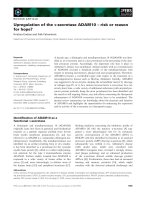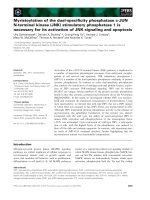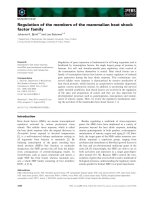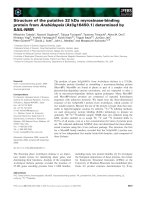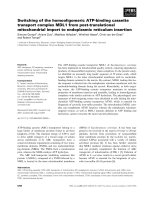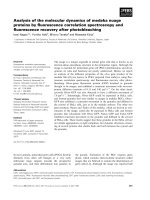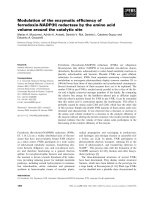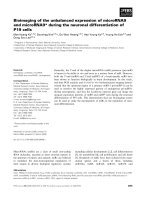Báo cáo khóa học: Disruption of the interaction between the Rieske iron–sulfur protein and cytochrome b in the yeast bc1 complex owing to a human disease-associated mutation within cytochrome b potx
Bạn đang xem bản rút gọn của tài liệu. Xem và tải ngay bản đầy đủ của tài liệu tại đây (337.42 KB, 7 trang )
Disruption of the interaction between the Rieske iron–sulfur protein
and cytochrome
b
in the yeast
bc
1
complex owing to a human
disease-associated mutation within cytochrome
b
Nicholas Fisher
1
, Ingrid Bourges
1
, Philip Hill
1
, Gael Brasseur
2
and Brigitte Meunier
1
1
Wolfson Institute for Biomedical Research, University College London, UK;
2
Laboratoire de Bioe
´
nerge
´
tique et Inge
´
nierie des
Prote
´
ines, CNRS, Marseille, France
The mitochondrial cytochrome b missense mutation,
G167E, has been reported in a patient with cardiomyopathy.
The residue G167 is located in an extramembranous helix
close to the hinge region of the iron–sulfur protein. In order
to characterize the effects of the mutation on the structure
and function of the bc
1
complex, we introduced G167E into
the highly similar yeast cytochrome b. The mutation had a
severe effect on the respiratory function, with the activity of
the bc
1
complex decreased to a few per cent of the wild type.
Analysis of the enzyme activity indicated that the mutation
affected its stability, which could be the result of an altered
binding of the iron–sulfur protein on the complex. G167E
had no major effect on the interaction between the iron–
sulfur protein headgroup and the quinol oxidation site, as
judged by the electron paramagnetic resonance signal, and
only a minor effect on the rate of cytochrome b reduction,
but it severely reduced the rate of cytochrome c
1
reduction.
This suggested that the mutation G167E could hinder the
movement of the iron–sulfur protein, probably by distorting
the structure of the hinge region. The function of bc
1
was partially restored by mutations (W164L and W166L)
located close to the primary change, which reduced the steric
hindrance caused by G167E. Taken together, these obser-
vations suggest that the protein–protein interaction between
the n-sulfur protein hinge region and the cytochrome b
extramembranous cd2 helix is important for maintaining
the structure of the hinge region and, by consequence, the
movement of the headgroup and the integrity of the enzyme.
Keywords: Saccharomyces cerevisiae; bc
1
complex; respir-
atory chain; disease; Rieske iron–sulfur protein.
The mitochondrial cytochrome bc
1
complex is a homo-
dimeric, membrane-spanning enzyme. It is formed from two
monomeric units consisting of 10polypeptide chains. Redox-
active prosthetic groups are located within three of these
polypeptides: cytochrome b, cytochrome c
1
and the Rieske
iron-suphur protein (ISP). The [2Fe)2S] prosthetic group
of the ISP is located within the soluble C-terminal domain
on the P-side of the inner mitochondrial membrane. This
domain consists of residues 93–215 (using the the yeast
sequence notation) and is linked by a flexible hinge (or linker)
region to a transmembrane helix anchored within the
inner mitochondrial membrane. This transmembrane helix
is unusually long and slants across the membrane to form a
functional moiety with cytochrome b and c
1
on the opposing
monomeric unit. Structural, biochemical and spectroscopic
data suggest that the peripheral C-terminal domain of the
ISP alternates between a position close to cytochrome b and
a position close to cytochrome c
1
, shuttling electrons from
quinone species bound at the quinol oxidation (Q
o
)siteto
the haem of cytochrome c
1
. The presence of a flexible hinge
region [sequence TADVLAMAK(85–93) in Saccharo-
myces cerevisiae] within the ISP facilitates this movement,
and this domain has been the target of extensive mutagenic
investigation. Insertion or deletion of residues has a signifi-
cant effect on the catalytic activity [1], whereas the enzyme
can accommodate various residue replacements without
loss of function.
In yeast, the ISP is synthesized as a 29 kDa precursor
protein with a 30 amino acid N-terminal leader sequence. It
is translated on cytoplasmic ribosomes and imported into
the mitochondria. Studies of the mechanism of assembly
of the bc
1
complex suggest that the ISP is one of the last
subunits to be integrated within the membrane-bound
subcomplex [2]. The integration of the ISP is facilitated
by Bcs1p, an AAA family member [3] that binds on the
precytochrome bc
1
complex [3].
The cytochrome b missense mutation, G167E, has been
detected in a patient with severe cardiomyopathy [4]. G167
is located in the extramembranous cd2 helix of cyto-
chrome b, a region not thought to be directly associated
with quinol binding at the Q
o
site. However, G167 is within
5A
˚
of residues forming the hinge region of the ISP (Fig. 1).
Replacement of glycine at position 167 by a bulkier and
potentially charged glutamate residue may interfere with
ISP movement, altering the catalytic activity of the
complex. Alternatively, the G167E mutation could affect
Correspondence to B. Meunier, Wolfson Institute for Biomedical
Research, University College London, Gower Street, London WC1E
6BT, UK. Fax: + 44 20 79165994, Tel.: + 44 20 76796860,
E-mail:
Abbreviations: EPR, electron paramagnetic resonance;
ISP, iron–sulfur protein; Q
o
, quinol oxidation site.
(Received 15 December 2003, revised 6 February 2004,
accepted 13 February 2004)
Eur. J. Biochem. 271, 1292–1298 (2004) Ó FEBS 2004 doi:10.1111/j.1432-1033.2004.04036.x
the integration or stability of the ISP within the bc
1
complex.
In order to investigate its effect on the bc
1
complex, we
introduced this ÔhumanÕ mutation into yeast cytochrome b
and studied the effects on complex assembly and activity.
Secondary suppressor mutations arising from the original
mutation were also identified.
Experimental procedures
Media and chemicals
The following media were used for the growth of yeast.
YPD, 1% (w/v) yeast extract, 2% (w/v) peptone, 3%
(w/v)glucose;YPG,1%(w/v)yeastextract,2%(w/v)
peptone, 3% (w/v) glycerol; transformation medium 0.7%
(w/v) yeast nitrogen base, 3% (w/v) glucose, 2% (w/v)
agar, 1
M
sorbitol and 0.8 gÆL
)1
of a complete supplement
mixture minus uracil, supplied by Anachem. Decylubi-
quinone was purchased from Sigma. Decylubiquinol was
prepared as described below. Stigmatellin was purchased
from Fluka.
Preparation of decylubiquinol
Ten milligrams of 2,3-dimethoxy-5-methyl-n-decyl-1,4-ben-
zoquinone (decylubiquinone), an analogue of ubiquinone
(Sigma) was dissolved in 400 lL of nitrogen-saturated
hexane. An equal volume of aqueous 1.15
M
sodium
dithionite was added, and the mixture was shaken vigor-
ously until colourless. The upper, organic phase was
collected, and the decylubiquinol recovered by evaporating
off the hexane under nitrogen. The decylubiquinol was
dissolved in 100 lL of 96% (v/v) ethanol (acidified with
10 m
M
HCl) and stored in aliquots at )80 °C. The
concentration of decylubiquinol was determined spectro-
photometrically from absolute spectra, using e
288)320
¼
4.14 m
M
)1
Æcm
)1
.
Generation of the mutant strains
The plasmid pBM5, carrying the wild-type intronless
sequence of the CYTB gene, was constructed by blunt end
cloning of a PCR product of CYTB into the pCRscript
vector (Stratagene). The mutagenesis was performed using
the Quickchange Site-Directed Mutagenesis Kit (Strata-
gene), according to the manufacturer’s recommendations.
After verification of the sequence, the plasmids carrying the
mutated genes were used for biolistic transformation. The
mitochondrial transformation by microprojectile bombard-
ment was adapted from the procedure of Bonnefoy & Fox
[5], as described previously [6,7].
Preparation of the mitochondrial membranes
and measurement of cytochrome
c
reductase activity
Wild type and mutant yeast strains were grown to stationary
phase (48 h) in 200-mL YPD cultures at 28 °C. The cells
( 2 g wet weight per culture) were harvested by centri-
fugation (4000 g, 10 min). Cell pellets were washed by
resuspension in 40 mL of 50 m
M
potassium phosphate,
Fig. 1. Location of the mutations in the cyto-
chrome bc
1
complex. The figure was prepared
using the coordinates of the yeast enzyme
(Protein Data Bank accession code 1KYO)
with visual molecular dynamics (VMD) [20].
The cytochrome b polypeptide backbone is
represented in orange, the iron–sulfur protein
(ISP) in green, residue G167 is shown in light
green, the compensatory mutations are shown
in pink, and the hinge region of the ISP is
shown in white.
Ó FEBS 2004 Effect of G167E mutation in the yeast bc
1
complex (Eur. J. Biochem. 271) 1293
2m
M
EDTA (pH 7.5) and centrifugation (4000 g,10min).
The harvested cells were resuspended in 10 mL of 50 m
M
potassium phosphate, 2 m
M
EDTA (pH 7.5), supplemen-
ted with 0.2 m
M
phenylmethanesulfonyl fluoride and
0.05% (w/v) BSA, prior to disruption (for 10 min at 4 °C)
in a Retsch MM300 glass bead mill operating at 30 Hz.
Membranes were separated from cell debris by centrifuga-
tion (10 000 g, 20 min). The supernatant was centrifuged
(100 000 g, 90 min) and the pelleted membranes were
resuspended in 1 mL of 50 m
M
potassium phosphate
(pH 7.5), 2 m
M
EDTA, containing 10% (v/v) glycerol.
Resuspended membranes were stored in 100-lL aliquots
at )80 °C. Cytochrome b concentration in the resuspended
membranes was adjusted to 2 l
M
.
Cytochrome c reductase activity measurements were
assayed in 50 m
M
potassium phosphate, pH 7.5, 2 m
M
EDTA, 10 m
M
KCN, 0.025% (w/v) lauryl maltoside and
30 l
M
equine cytochrome c, at room temperature. Mem-
branes were diluted to 2.5 n
M
cytochrome bc
1
complex
(determined from the reduced minus oxidized difference
spectra, using the bovine cytochrome b extinction coeffi-
cient: e ¼ 28.5 m
M
)1
Æcm
)1
at 562–575 nm [8]). Cyto-
chrome c reductase activity was initiated by the addition
of decylubiquinol (5–100 l
M
). Reduction of cytochrome c
was monitored in a Cary 4000 spectrophotometer at 550
vs. 542 nm. Initial rates were measured as a function of
decylubiquinol concentration, and V
max
and K
m
values were
derived from Eadie–Hofstee (v vs. v/[S]) plots.
Spectroscopic analysis of cytochromes in whole cells
Spectra were generated by scanning dithionite-reduced cell
suspensions with a Cary-4000 spectrophotometer at room
temperature. The cells, grown on YPD plates for 48 h, were
resuspended at a concentration of 200 mgÆml
)1
. Quad-
ratic baseline compensation was carried out on the data,
as described previously [9], to remove the distortion of
the baseline.
Western blotting analysis
Immunodetection analyses were performed on crude
mitochondrial membranes. A loading solution of 62.5 m
M
Tris/HCl (pH 6.8), 0.01% (w/v) bromophenol blue, 25%
(v/v) glycerol, 2% (w/v) SDS, 5% (v/v) 2-mercaptoeth-
anol, was added to each sample (1 : 2, v/v). The samples
were then heated for 5 min at 95 °C. The analyses were
performed as described previously [10]. The mitochond-
rial membrane preparations (40 lg of total protein per
sample) were electrophoresed on SDS/polyacrylamide
gels (4–20% linear gradient polyacryamide gel) prior to
transfer to poly(vinylidene difluoride) membrane by
semidry electroblotting. ÔPrecision Plus Protein Dual
Color standardsÕ (Bio-Rad) (10–250 kDa) were used for
estimation of molecular mass. Polyclonal antisera against
cytochrome c oxidase subunits VI and VIa were kindly
supplied by J. W. Taanman (Royal Free and University
College Medical School, London, UK). Polyclonal anti-
sera against cytochrome c
1
, Rieske iron–sulfur protein
and QCR7 were generously supplied by B. L. Trum-
power (Dartmouth Medical School, Hanover, NH,
USA).
Pre-steady state cytochrome reduction kinetics
The reduction kinetics of cytochrome b and cytochromes c
and c
1
were monitored using a dual-wavelength Aminco
DW2A spectrophotometer equipped with a rapidly stirred
reaction cuvette, as described previously [11].
Electron paramagnetic resonance (EPR) analysis
EPR analysis was performed as described previously [11].
Results and discussion
Effect of the mutation G167E on the assembly
and function of the
bc
1
complex
The mutation G167E was introduced into yeast cyto-
chrome b by the biolistic method, as described previously
[6,12]. The resulting mutant was respiratory growth defici-
ent. The effect of the mutation on cytochrome b content in
whole cells was monitored spectrophotometrically (Fig. 2).
The aerobic spectrum of the mutant cells (Fig. 2, G167E ox)
showed a peak at 562 nm, corresponding to reduced
cytochrome b (presumably high potential cytochrome b
haem), and a peak at 575 nm, corresponding to oxy-
flavohemoprotein [13]. After a 1 min incubation, the cell
suspension became anaerobic as a result of respiration.
Cytochrome c and cytochrome c oxidase were reduced and
the signal of oxyflavohemoprotein disappeared (Fig. 2,
G167E red, lower trace). The addition of dithionite had little
effect (Fig. 2, G167E red, upper trace). The wild type cells
demonstrated fast O
2
consumption, with the cell suspen-
sions becoming anaerobic immediately and the cytochromes
becoming fully reduced (Fig. 2, WT red). The cytochrome b
content of the mutant cells (based on the reduced spectra
in the visible region) was decreased by 25% compared to
Fig. 2. Optical spectra of the wild type and mutant cells. Optical spectra
of cell suspensions of the wild type (wt) and mutant (G167E) were
obtained as described in the Experimental procedures. wt red, Spec-
trum of reduced (anaerobic) wild type cells; G167E red, spectra of
reduced mutant cells. The lower trace shows the degree of reduction
upon anaerobiosis, and the upper trace is the same sample upon
addition of dithionite. G167E ox, spectrum of aerobic mutant cells.
1294 N. Fisher et al. (Eur. J. Biochem. 271) Ó FEBS 2004
the wild type level. It appeared therefore that the G167E
mutation had little effect on the folding or assembly of
cytochrome b. In order to monitor the content of ISP in
cells, membranes were prepared as described above, in the
Experimental procedures. The steady-state levels of the ISP,
cytochrome c
1
and two cytochrome oxidase subunits (cox
VI and cox VIa) were monitored by immunoblotting. As
shown in Fig. 3, the level of ISP seemed similar to that of
the wild type sample. However, variations in the ISP content
were observed between different mitochondrial membrane
preparations (data not shown). This could be a result of
the instability of the mutant enzyme and an increased
sensitivity to degradation during membrane preparation,
as discussed below.
The decylubiquinol (QH
2
)-cytochrome c reductase activ-
ity of the mitochondrial membranes was measured spectro-
photometrically at pH 7.5, as described in the Experimental
procedures. All measurements were made at room tem-
perature. The bc
1
QH
2
-cytochrome c reductase activity of
the G167E mutant was severely decreased, exhibiting a
maximal turnover number of 11 s
)1
at 40 l
M
QH
2
.This
compares to a turnover number of 50 s
)1
observed for
the wild type enzyme under identical assay conditions at the
same concentration of quinol. Unexpectedly, increasing the
quinol concentration above 40 l
M
resulted in a decreased
activity of the G167E mutant (Fig. 4A). At 65 l
M
QH
2
,the
turnover number of the mutant was decreased to 4 s
)1
,8%
of the wild type rate. As such, K
m
and V
max
are not useful
parameters for the kinetic description of this mutant. The
probable reason for this phenomenon (namely enzyme
instability) is discussed in greater detail below.
Instability of the mutant enzyme
Further analysis of the kinetic parameters of the G167E
mutant was hindered by rapid inhibition of the activity of
the bc
1
complex during the assay, which was particularly
noticeable at higher quinol concentrations (as shown in
Fig. 4B). The inhibition of the enzyme by its product
quinone could be excluded, because the addition of an equal
amount of decylubiquinone to decylubiquinol at the begin-
ning of the assay had no effect on the kinetics (data not
shown). It is more probable that the mutant was unstable
under the conditions of the assay. This was confirmed by
monitoring the sensitivity of the activity of the bc
1
complex
to detergent. The mutant enzyme was inactivated by a 2 min
incubation with 0.025% (w/v) lauryl maltoside, with 50%
activity lost after a 90 s incubation. The wild type bc
1
complex did not show this behaviour. It seems probable that
the biphasic nature of the kinetic data, presented in Fig. 4B,
results from the instability of the enzyme in dilute solution in
the presence of detergent. The decrease in activity observed
at quinol concentrations of > 40 l
M
(Fig. 4A) may be a
result of the weakly chaotropic nature of the substrate
and the inherent partioning of quinol into the Q
o
site. The
Fig. 3. Steady-state level of the iron–sulfur protein (ISP) in G167E.
Immunoblots of denaturing gels, loaded with 40 lg of protein from
mutant and wild type membrane preparations, were probed with
antibodies specific for cytochrome c
1
or the ISP. The loading was
monitored using antibodies against the cytochrome oxidase subunits
cox VI and cox VIa.
Fig. 4. QH
2
-cytochrome c reductase activity. The assays were per-
formed as described in the Experimental procedures. QH
2
-cyto-
chrome c reductase activity was measured spectrophotometrically, at
room temperature, at 550 minus 542 nm in an assay buffer consisting of
50 m
M
potassium phosphate, 2 m
M
EDTA, 10 m
M
potassium cyanide,
30 l
M
equine cytochrome c and 0.025% (w/v) lauryl maltoside, pH 7.5.
The concentration of bc
1
complex in the activity assay was 2.5 n
M
.
(A) Activity of the mutant enzyme as a function of the substrate QH
2
concentration. (B) The rate of cytochrome c reduction by wild type (wt)
and mutant (G167E) membranes at 66 l
M
QH
2
.
Ó FEBS 2004 Effect of G167E mutation in the yeast bc
1
complex (Eur. J. Biochem. 271) 1295
activity of the human G167E mutant bc
1
complex has been
assayed in postmortem heart homogenates, and was found
to be 23% of the control rate [4]. The addition of lauryl
maltoside, which stimulated the bc
1
activity of control
samples, inhibited the activity in samples from the patient.
This was in agreement with the data obtained in this study,
using the mutant yeast enzyme. It has been reported that a
mutation in the hinge region of the Rhodobacter sphaeroides
bc
1
complex, which reduced the flexibility of the neck region,
increased the sensitivity of the enzyme to detergent, with
activity lost as a result of destabilization of the ISP [14].
It seems probable that this is also the case for the G167E
mutant, and that activity is lost owing to the destabilization
of the complex (loss of the ISP) on dilution or exposure
to detergent. Weakened ISP binding, as a result of the
introduction of a bulky and potentially charged glutamate
residue at position 167, may also explain the variations in
the ISP content observed in different membrane prepara-
tions. The integrity of the complex appears to be sensitive to
the protein/lipid ratio. It is also possible that the G167E
mutation increased the sensitivity of the ISP to proteolytic
cleavage. Study of the R. sphaeroides bc
1
complex has
shown that the hinge region of the ISP is sensitive to
proteolytic cleavage by various proteases. As the degree of
proteolysis varied in mutants, it was suggested that muta-
tions altered the conformation of the hinge region, increas-
ing its accessibility to proteases [15]. As G167 is located close
to residues in the hinge region (Fig. 1), the introduction of
glutamate could alter the structure of this domain, facilita-
ting proteolytic attack.
Note that further analyses of the bc
1
complex were
performed using the membrane preparations with a high
ISP content, as shown in Fig. 3.
Selection and characterization of reversions
From the respiratory deficient mutant, G167E, revertants
(respiratory growth competent clones) were selected on
respiratory medium. The cytochrome b gene of the rever-
tants was sequenced. Three compensatory mutations were
found: a mutation at the same codon restoring G167; and
two mutations in close proximity to G167E, namely W164L
and W166L. These two mutations only partially compensa-
ted for the respiratory defect because the doubling time of the
revertants in respiratory medium was 15 h (the doubling
time is 4 h in the wild-type strain, at 28 °C). The bc
1
QH
2
-
cytochrome c reductase activity of the revertants, assayed
as described above in the Experimental procedures, showed
only a 2.7-fold increase compared to the primary mutant. It is
probable that the replacement of tryptophan by the smaller
aliphatic residue, leucine, reduced the steric (or electrostatic)
hindrance caused by G167E. However, the secondary
mutations were not fully compensatory, because, in the
revertants, the bc
1
activity remained low and the instability of
the complex persisted, as observed for the primary mutant.
In order to monitor the effect of the secondary mutations
(W164L and W166L) alone on the function of the bc
1
complex, we introduced these changes into wild type
cytochrome b by the biolistic method (as described in the
Experimental procedures). These mutations had no effect
on the respiratory growth or bc
1
assembly and activity
compared to wild type cells (data not shown). Thus, the
replacement of tryptophan with a smaller residue (leucine) at
positions 164 or 166 can be accommodated by the enzyme.
Pre-steady state reduction of cytochromes
b
and
c
1
In order to investigate which step was modified in the
overall steady-state electron transfer from ubiquinol to
cytochrome c, the kinetics of reduction of cytochromes b
and c
1
were measured in the mutant and revertant strains.
The rates of reduction of cytochromes c + c
1
,inmutants
and revertants, was decreased to 35% of the wild type
rate (Fig. 5A). The cytochrome b reduction kinetic
(Fig. 5B), by the center P pathway (in the presence of
antimycin), was decreased to 70% of the wild type rate
in the mutants and revertants. Thus, the reduction of
c +c
1
was significantly slower than in the wild type strain,
whereas the reduction of b was less affected. The slow
c +c
1
reduction could be caused by hindered ISP
movement, as a result of G167E.
Q
o
site occupancy, as examined by EPR spectroscopy
With the quinone pool oxidized, the mutant G167E and the
revertant G167E + W166L showed a wild type EPR signal
(Fig. 5A), indicating a full occupancy of the site by quinone.
This suggested that the ISP headgroup of the mutant
enzyme interacted normally with the Q
o
site. When the Q
Fig. 5. Pre-steady state kinetics. Pre-steady state measurements were
performed using mitochondrial membranes, as described in the
Experimental procedures. (A) Kinetics of c+ c
1
reduction; (B) kinetics
of cytochrome b reduction.
1296 N. Fisher et al. (Eur. J. Biochem. 271) Ó FEBS 2004
pool was reduced, the g
x
signal in the mutant was downfield
shifted (g
x
¼ 1.795) compared to the wild type. The
difference in the g
x
signal between Q pool oxidized and
reduced was thus lower in the mutant (1.8–1.795) than the
wild type strain (from 1.8 to 1.78). The nature of this shift in
G167E is not, at present, understood, but it may reflect a
slightly different positioning of the ISP with quinol in the
Q
o
site. Addition of stigmatellin induced a g
x
trough centred
at g ¼ 1.775 in the wild type strain. It was slightly upfield
shifted in G167E (g
x
¼ 1.765). More interestingly, the
revertant G167E + W166L exhibited a double trough
(g
x
¼ 1.8 and g
x
¼ 1.76) in the presence of stigmatellin
(Fig. 6C), but it should be noted that this feature is also
detectable in the EPR spectrum with the Q pool reduced
(Fig. 6B). A similar double g
x
signal has already been
observed in mutant forms of the Rhodobacter capsulatus bc
1
complex, when the Q pool is oxidized [16]. This feature was
particularly noticeable in a revertant obtained from mutant
T265S (yeast numbering) harbouring the suppressor muta-
tion, V164A, in ISP. The nature of this double trough
remains unclear. It may reflect subtle structural heterogen-
eity in the sample, corresponding to two subpopulations of
enzyme with their ISP in different conformations.
The mutation G167E could distort the hinge region
of the ISP and hinder the movement of the headgroup
Mutations in the hinge region of the ISP, which were shown
to decrease linker flexibility, have been previously studied in
R. sphaeroides. The mutant enzyme, in which residues ADV
(position 86–88 yeast numbering) were replaced with PPP,
was inactive but showed a normal EPR signal. The addition
of detergent restulted in the loss of the ISP, which suggested
that the mutation weakened the binding of the subunit to the
complex [14]. The replacement of residues ADV with PLP
was less deleterious. The bc
1
complex showed a low activity,
but without loss of the ISP. This mutant again showed a
normal EPR spectrum. Arrhenius plots of temperature
dependence of bc
1
activity in the mutant showed a higher
activation energy. Therefore, it seemed probable that the
increased rigidity of the hinge region increased the activation
energy, and that the movement of the ISP would become the
rate-limiting step of the Q
o
site reaction [14]. In yeast, the
mutation A86L in the ISP hinge region caused a decrease in
bc
1
activity of 60%, without loss of the ISP or change in the
EPR signal. It was suggested that the mutation impeded
the unwinding of the short stretch of the 3
10
helix located in
the tether region necessary for the movement of the ISP
headgroup. Consequently, the mutant enzyme had a dimin-
ished activity. This was supported by the higher activation
energies calculated for the mutant [17]. The insertion of one
alanine residue in the hinge region of the R. capsulatus ISP
decreased bc
1
complex activity, presumablyowing to reduced
mobility of the ISP [18]. The same mutation was introduced
in yeast. It also decreased the turnover, to 50% of the wild
type rate [1]. It was suggested that mutation increased the
ÔcleftÕ between ISP and cytochrome b, and modified the
Q
o
-binding site. This was supported by the observed decrease
in sensitivity to stigmatellin in the mutant enzyme.
It is probable that G167E affects the bc
1
complex function
in away similar to the hingeregion mutations, and we suggest
that G167E hinders the movement of the ISP by altering the
ISP–cytochrome b interaction at the hinge region. Move-
ment of the extrinsic domain of the ISP is facilitated by the
unwinding of a single turn of the 3
10
helix formed from
residues ADV(86–88). G167 is located 9 A
˚
from A86 (and
4A
˚
from A84) and thus it seems probable that replacement
of this residue with glutamate could interfere with the
movement of theISP, which would, in turn, alter the catalytic
activity of the complex. The mutation could also affect the
binding of the ISP to the bc
1
complex and distort the Q
o
site.
Our data showed that, in the mutant, the bc
1
activity was
severely decreased. The kinetics of reduction of cytochrome
c +c
1
were significantly more affected than the kinetics of
cytochrome b reduction. EPR spectra in the presence of an
oxidized Q pool were normal, which showed that the site was
fully occupied by quinone and that the environment of the
Fig. 6. Quinol oxidation (Q
o
) site occupancy probed by electron para-
magnetic resonance (EPR) spectra of the iron–sulfur protein (ISP)
[2Fe)2S] cluster. EPR spectra were recorded after mitochondrial
membranes were reduced (A) with 10 m
M
ascorbate (Q pool oxidized),
(B) with a few grains of dithionite (Q pool completely reduced), or (C)
after the addition of stigmatellin at a final concentration of 10 l
M
.
Arrows and vertical dotted lines indicate the g-values. Spectra obtained
in the presence of dithionite (B) exhibited a lower g
y
¼ 1.90 signal
because of a negative contribution of the complex II iron–sulfur
clusters. EPR conditions were as follows: temperature, 15 K; micro-
wave frequency, 9.42 GHz; microwave power, 6.3 mW; modulation
frequency, 100 kHz; and modulation amplitude, 1.6 mT.
Ó FEBS 2004 Effect of G167E mutation in the yeast bc
1
complex (Eur. J. Biochem. 271) 1297
[2Fe)2S] cluster wasnot affected. This argued in favour of an
effect of the G167E mutation on the movement of the ISP,
and not on the Q
o
site structure. However, the EPR signal in
the presence of reduced quinol and stigmatellin was modified,
suggesting a slight alteration in the interaction between the
ISP headgroup and the quinol- or sigmatellin-bound Q
o
site.
The mutant enzyme was sensitive to detergent and unstable
under the assay conditions. It is suggested that the ISP was
progressively lost during the assay, or that its integration
within the complex was progressively distorted, causing
further inhibition of the enzyme activity. An altered protein–
protein interaction between the ISP hinge region and the
cytochrome b extramembranous cd2 helix may result in
enzyme instability.
In R. capsulatus it was suggested that the mutation T265S
(located in the ef loop of cytochrome b) hindered the
movement of the ISP. The enzyme function was restored
by a secondary mutation, G167S [16]. G167S has also been
found as a suppressor of the mutation T148F, which
abolishes the enzyme assembly [19]. Thus, it seems that
G167S could strengthen the assembly of the mutant complex
(T148F + G167S), or modify the structure of the ISP to
allow its movementin the mutant enzyme (T265S + G167S).
The effect of G167S alone was also studied. The change
decreased the activity ofthecomplexand the steady-statelevel
of ISP [19].ResidueG167 is highlyconservedbetween species,
and it can be suggested that glycine at this position is required
for the proper folding of the hinge region in the assembled
complex. The replacement of G167 with serine (in R. capsul-
atus) or glutamate (in yeast or humans) may affect the
structure of the hinge region, resulting in a hindered move-
ment and enzyme instability. As suggested previously for a
yeast mutant with a +1 alanine insertion in the hinge region
[1], G167E (and G167S to a lesser extent) could increase
the size of the cleft between the ISP and cytochrome b.
In conclusion, the observations reported here, for the
yeast cytochrome b G167E mutant, suggest that interfacial
protein–protein interactions between the hinge region of ISP
and the extramembranous cd2 helix of cytochrome b are
important for maintaining the structure of the hinge region
and, by consequence, the movement of the headgroup and
the integrity of the enzyme.
Acknowledgements
The work was supported by a Medical Research Council Fellowship to
B.M.
References
1. Nett, J.H., Hunte, C. & Trumpower, B.L. (2000) Changes to the
length of the flexible linker region of the Rieske protein impair the
interaction of ubiquinol with the cytochrome bc
1
complex. Eur.
J. Biochem. 267, 5777–5782.
2. Grivell, L.A. (1989) Nucleo–mitochondrial interactions in mit-
ochondrial biogenesis. Eur. J. Biochem. 182, 477–493.
3. Cruciat, C M., Hell, K., Fo
¨
lsch,H.,Neupert,W.&Stuart,R.A.(1999)
Bcs1p, an AAA-family member, is a chaperone for the assembly of
the cytochrome bc
1
complex. EMBO J. 18, 5226–5233.
4. Valnot, I., Kassis, J., Chretien, D., De Lonlay, P., Parfait, B.,
Munnich, A., Kachaner, J., Rustin, P. & Ro
¨
tig, A. (1999)
A mitochondrial cytochrome b mutation but no mutation of
nuclearly encoded subunits in ubiquinol cytochrome c reductase
(complex III) deficiency. Hum. Genet. 104, 460–466.
5. Bonnefoy, N. & Fox, T.D. (2001) Genetic transformation of
Saccharomyces cerevisiae mitochondria. Methods Cell Biol. 65,
381–396.
6. Bratton, M., Mills, D., Castleden, C.K., Hosler, J. & Meunier, B.
(2003) Disease-related mutations in cytochrome c oxidase studied
in yeast and bacterial models. Eur. J. Biochem. 270,1–9.
7. Hill,P.,Kessl,J.J., Meshnick,S.R., Trumpower,B.L. &Meunier,B.
(2003)Recapitulation in Saccharomyces cerevisiae of cytochrome b
mutations conferring resistance to atovaquone in Pneumocystis
jiroveci. Antimicrob. Agents Chemother. 47, 2725–2731.
8. Vanneste, W.H. (1966) Molecular proportion of the fixed cyto-
chrome components of the respiratory chain of Keilin-Hartree
particles and beef heart mitochondria. Biochim. Biophys. Acta 113,
175–178.
9. Brown, S., Colson, A M., Meunier, B. & Rich, P.R. (1993) Rapid
screening of cytochromes of respiratory mutants of Saccharo-
myces cerevisiae – application to the selection of strains containing
novel forms of cytochrome c oxidase. Eur. J. Biochem. 213, 137–
145.
10. Saint-Georges, Y., Bonnefoy, N., di Rago, J P., Chiron, S. &
Dujardin, G. (2002) A pathogenic cytochrome b mutation reveals
new interactions between subunits of the mitochondrial bc
1
com-
plex. J. Biol. Chem. 277, 49397–49402.
11. Brasseur,G., di Rago, J P., Slonimski, P.P. & Lemesle-Meunier, D.
(2001) Analysis of suppressor mutation reveals long distance
interactions in the bc
1
complex of Saccharomyces cerevisiae.
Biochim. Biophys. Acta 1506, 89–102.
12. Jones, S., Tasab, M., Ogden, J.E., Ballance, D.J. & Powell, M.J.
(1996) Expression of rat neuronal nitric oxide synthase in Sac-
charomyces cerevisiae. J. Biotechnol. 48, 37–41.
13. Gardner, P.R., Gradner, A.M., Martin, L.A., Dou, Y., Li, T.,
Olson, J.S.Z.H. & Riggs, A.F. (2000) Nitric-oxide dioxygenase
activity and function of flavohemoglobins. J. Biol. Chem. 275,
31581–31587.
14. Tian, H., Yu, L., Mather, M.W. & Yu, C.A. (1998) Flexibility of
the neck region of the Rieske iron–sulfur protein is functionally
important in the cytochrome bc
1
complex. J. Biol. Chem. 273,
27953–27959.
15. Valkova-Valchanova, M., Darrouzet, E., Moomaw, C.R.,
Slaughter, C.A. & Daldal, F. (2000) Proteolytic cleavage of the
Fe-S subunit hinge region of Rhodobacter capsulatus bc
1
complex:
effects of inhibitors and mutations. Biochemistry 39, 15484–15492.
16. Darrouzet, E. & Daldal, F. (2003) Protein–protein interactions
between cytochrome b and the FeS protein subunits during QH
2
oxidation and large-scale domain movement in the bc
1
complex.
Biochemistry 42, 1499–1507.
17. Ghosh, M., Wang, Y., Ebert, E., Vadlamuri, S. & Beattie, D.S.
(2001) Substituting leucine for alanine-86 in the tether region of
the Iron-Sulfur protein of the cytochrome bc
1
complex affects the
mobility of the [2Fe2S] domain. Biochemistry 40, 327–335.
18. Darrouzet, E., Valkova-Valchanova, M., Moser, C.C., Dutton,
P.L. & Daldal, F. (2000) Uncovering the [2Fe2S] domain move-
ment in cytochrome bc
1
and its implication for energy conversion.
Proc. Natl Acad. Sci. USA 97, 4567–4572.
19. Saribas, A.S., Valkova-Valchanova, M., Tokito, M.K., Zhang, Z.,
Berry, E.A. & Daldal, F. (1998) Interactions between the
cytochrome b, cytochrome c
1
, and Fe-S protein subunits at the
ubihydroquinone oxidation site of the bc
1
complex of Rhodobacter
capsulatus. Biochemistry 37, 8105–8114.
20. Humphrey, W., Dalke, A. & Schulten, K. (1996) VMD – visual
molecular dynamics. J. Mol. Graph. 14, 33–38.
1298 N. Fisher et al. (Eur. J. Biochem. 271) Ó FEBS 2004


